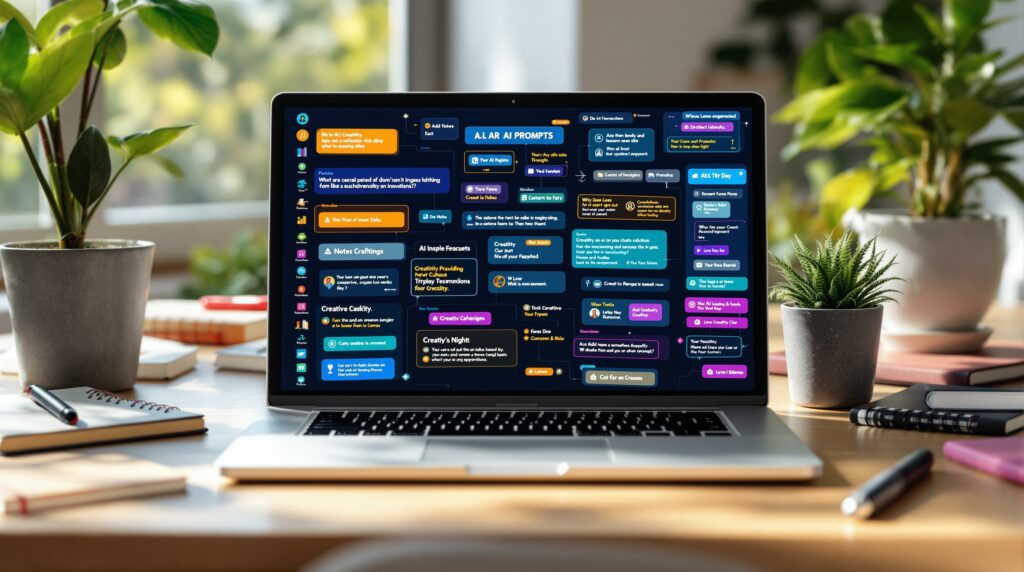Listen to this article
In the ever-evolving landscape of artificial intelligence, the ability to craft effective ai prompt writing has become a critical business skill. Whether your organization is leveraging OpenAI’s ChatGPT, Google’s Gemini, or Anthropic’s Claude, the quality of your prompts can significantly influence the value you extract from these tools.
At InnovareAI, we’ve helped dozens of B2B companies transform their operations through strategic AI implementation, and we’ve seen firsthand how prompt engineering drives efficiency, innovation, and competitive advantage. This article delves into the art and science of AI prompt writing for business, offering actionable insights to help you unlock the full potential of advanced language models in your organization.
The Rise of Prompt Engineering: Why It Matters for Business
The term “prompt engineering” has gained traction in recent years, and for good reason. As AI systems become more sophisticated, their ability to generate nuanced, context-aware responses depends heavily on the instructions they receive. Think of a prompt as the steering wheel of a car: it determines the direction, speed, and overall journey. In a business context, this means prompts can shape everything from customer communications to internal reports and strategic planning.
Unlike traditional programming, where explicit code dictates behavior, working with AI models involves a more conversational approach. This shift has democratized access to AI, enabling non-technical business users to harness its power for a wide range of applications—from automating customer support to generating sales proposals and analyzing market trends. However, it has also introduced a new challenge: how do you communicate effectively with a machine that “thinks” in probabilities rather than absolutes, especially when business outcomes are on the line?
Understanding the Foundations of AI Prompt Writing
Before diving into specific techniques, it’s essential to understand the underlying mechanics of AI models like ChatGPT, Gemini, and Claude. These systems are built on large language models (LLMs), which are trained on vast datasets to predict the next word in a sequence. This predictive capability allows them to generate coherent and contextually relevant responses to a wide variety of business queries.
However, these models are not omniscient. They rely on the information provided in the prompt to generate their output. A well-crafted prompt acts as a guide, narrowing the model’s focus and increasing the likelihood of accurate, useful responses. In a B2B setting, this means that the more context and clarity you provide, the more likely you are to receive outputs that align with your business objectives, compliance requirements, and brand voice.
Key Principles for Writing Effective Prompts in Business
To master the art of AI prompt writing for business, consider the following principles:
Clarity is King
Ambiguity is the enemy of effective communication, especially when dealing with AI. Ensure your prompts are clear, concise, and free of jargon that might confuse the model. For example, instead of asking, “What are the benefits of AI?” try, “List three benefits of using AI in supply chain management for a manufacturing company.” This level of clarity helps the model deliver more targeted and actionable responses.
Context is Crucial
Providing context helps the model understand the scope and intent of your query. In a business environment, this might mean specifying the industry, department, or use case. For instance, if you’re asking about AI applications, clarify whether you’re interested in marketing automation, HR analytics, or financial forecasting. The more context you provide, the more relevant the output will be.
Be Specific, But Not Overly
Restrictive Striking the right balance between specificity and flexibility is key. A prompt like “Write a 500-word article on the benefits of AI in B2B sales enablement” is more effective than “Tell me about AI.” However, avoid over-constraining the model with too many requirements, as this can limit its ability to generate creative or comprehensive responses.
Iterate and Refine Prompt writing is an iterative process
Experiment with different phrasings and structures to see what works best for your business needs. Use the model’s feedback to refine your approach, and don’t hesitate to adjust your prompts based on the quality of the responses you receive.
Leverage System Prompts and Templates
Many AI platforms allow you to set system-level instructions that influence the model’s behavior. For example, you can instruct the model to adopt a formal tone, prioritize accuracy over creativity, or follow specific compliance guidelines. Developing prompt templates for common business tasks—such as drafting client emails, generating product descriptions, or summarizing meeting notes—can help ensure consistency and efficiency across your organization.
Techniques for Crafting Better Prompts in B2B Settings
Now that we’ve covered the foundational principles, let’s explore some advanced techniques for writing better prompts that drive business value.
- Use Role-Playing to Set Context. One of the most effective ways to guide an AI model is by assigning it a specific business role. For example: “You are a financial advisor.
Explain the benefits of investing in renewable energy for enterprise clients.” “Act as a compliance officer and review this draft contract for potential regulatory issues.” This technique helps the model adopt a more focused perspective, leading to more relevant and accurate responses for your business context. - Incorporate Examples. Providing examples within your prompt can clarify your expectations and set a benchmark for the model to follow. For instance: “Write a product description for a B2B SaaS platform.
Example: ‘Our platform streamlines procurement workflows, integrates seamlessly with ERP systems, and offers real-time analytics for enterprise clients.'” By including an example, you help the model understand the desired tone, structure, and level of detail. - Ask for Step-by-Step Explanations. When dealing with complex business topics, ask the model to break down its response into steps.
For example: “Explain how to implement a data privacy policy in a multinational organization, step by step.” “Provide a step-by-step guide to onboarding new enterprise customers to our cloud platform.” This approach not only improves the clarity of the response but also makes it easier for teams to follow and implement. - Experiment with Temperature and Max Tokens. Most AI platforms allow you to adjust parameters like temperature (which controls randomness) and max tokens (which limits response length). Experimenting with these settings can help you fine-tune the model’s output for different business scenarios.
For example: A lower temperature (e.g., 0.2) produces more deterministic responses, ideal for compliance documentation or technical writing. A higher temperature (e.g., 0.8) encourages creativity, suitable for brainstorming marketing campaigns or product names. - Use Multi-Turn Conversations. For complex business tasks, consider breaking your query into multiple steps. Start with a broad question, then narrow the focus based on the model’s initial response.
For example: “What are the key challenges in AI adoption for mid-sized enterprises?” “How can IT leaders in manufacturing overcome these challenges?” This iterative approach allows you to build on the model’s output, creating a more comprehensive and nuanced dialogue that mirrors real business conversations.
- Use Role-Playing to Set Context. One of the most effective ways to guide an AI model is by assigning it a specific business role. For example: “You are a financial advisor.
Common Pitfalls to Avoid in B2B Prompt Engineering
Even experienced users can fall into common traps when writing prompts for business applications. Here are a few to watch out for:
Overloading the Prompt Avoid cramming too much information into a single query. If you need the model to perform multiple tasks—such as summarizing a report, identifying key risks, and suggesting next steps—break these into separate prompts. This not only improves the quality of each response but also makes it easier to review and act on the outputs.

Ignoring Model Limitations Remember that AI models are not infallible. They may generate incorrect, outdated, or biased responses, especially in specialized or regulated industries. Always verify critical information, and consider implementing a human-in-the-loop review process for high-stakes outputs.
Failing to Provide Feedback If the model’s response doesn’t meet your expectations, refine your prompt and try again. Establish feedback loops within your team to share successful prompts and flag common issues. Over time, this collective learning will improve the quality and consistency of AI-generated content across your organization.
Neglecting Compliance and Security In B2B environments, data privacy, compliance, and security are paramount. Never include sensitive or confidential information in your prompts, and always review AI outputs for compliance with industry regulations and company policies. Consider working with your legal and IT teams to develop guidelines for safe and responsible AI use.
The Future of AI Prompt Writing in Business
As AI technology continues to advance, the importance of effective prompt writing will only grow for B2B organizations. Emerging trends—such as multimodal models that handle text, images, and data, as well as real-time learning and workflow automation—will introduce new opportunities and challenges for business users. Staying ahead of these developments requires a commitment to continuous learning, experimentation, and cross-functional collaboration.
At InnovareAI, we’re constantly researching and implementing these emerging trends to help our clients stay at the forefront of AI adoption. Forward-thinking companies are already investing in prompt engineering training for their teams, developing internal libraries of tested prompts, and integrating AI into their core business processes. By doing so, they are not only improving efficiency and innovation but also building a foundation for responsible and scalable AI adoption.
Real-World Applications: Prompt Engineering for Sales Outreach
The principles of effective prompt engineering can be directly applied to sales outreach automation, as demonstrated by our approach at InnovareAI. Our AI-powered outreach system addresses common pain points in B2B sales:
Inconsistent Results: By using carefully engineered prompts, our system maintains consistent quality across all communications, eliminating the variability often seen with remote VAs.
Response Time: Our AI analyzes replies in real-time and generates appropriate follow-ups instantly, ensuring hot leads never go cold due to delayed responses.
End-to-End Automation: Well-crafted prompts enable our system to handle the entire outreach process from prospecting to follow-up, removing the need for constant human supervision.
Cost-Effective Scaling: Our system’s prompt-based architecture allows it to scale without proportional cost increases, unlike traditional per-lead or per-action fee structures.
The results speak for themselves: “We’ve doubled our qualified meetings while cutting our outreach costs by 60%. The system runs in the background while our team focuses on closing deals,” reports one of our clients.
This real-world application demonstrates how strategic prompt engineering can transform business processes beyond content creation, extending to core revenue-generating activities like sales outreach.

Prompts for Visual Content Creation
As businesses increasingly rely on visual content, prompt engineering extends beyond text to include generating infographics, charts, and other visual assets. Effective prompts for visual content should:
- Specify the exact type of visual (e.g., “Create a comparison infographic showing traditional vs. AI-powered sales outreach”)
- Include data points to be visualized (e.g., “Include the following metrics: 60% cost reduction, 2x increase in qualified meetings”)
- Define the style and branding elements (e.g., “Use a professional blue and teal color scheme with our logo in the bottom right”)
- Clarify the intended audience and purpose (e.g., “Design for LinkedIn audience of sales directors and VPs”)
- Request specific visual elements (e.g., “Include icons representing automation, time savings, consistency, and cost reduction”)
By applying these principles, B2B companies can create compelling visual assets that complement their written content and drive engagement across channels.

Unlocking the Full Potential of AI for Your Business
Mastering the art of AI prompt writing is not just a technical skill—it’s a strategic business capability. By understanding the principles, techniques, and pitfalls outlined in this article, your organization can harness the power of ChatGPT, Gemini, and Claude to achieve your goals—whether you’re automating routine tasks, generating high-quality content, or driving data-driven decision-making.
The journey to better prompt writing is one of discovery and growth. Embrace the process, invest in team training, and foster a culture of experimentation. In doing so, you’ll find that the possibilities for AI in your business are limited only by your i
Ready to transform your business with strategic AI prompt engineering?
Are you leading the change in AI adoption—or waiting for it to happen?


